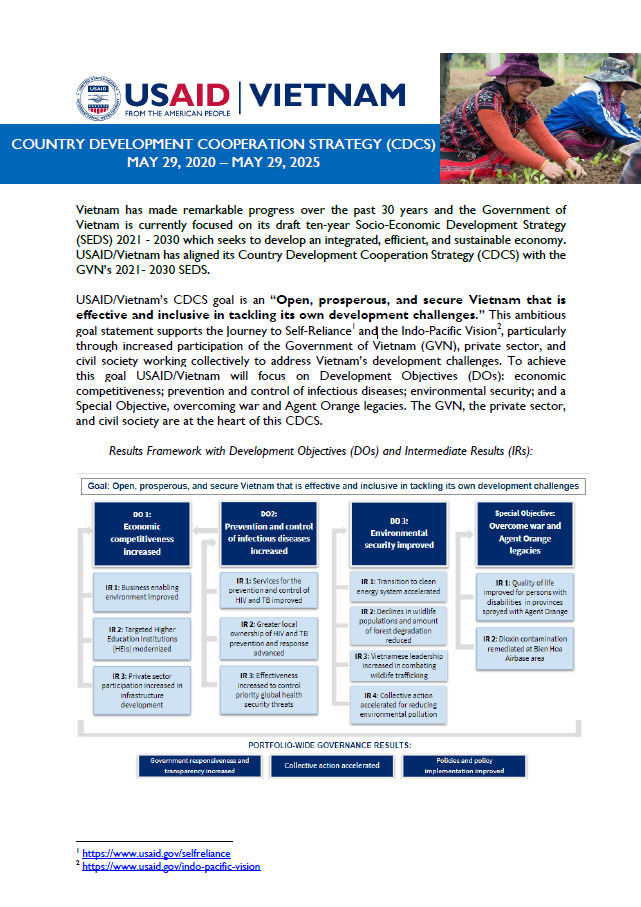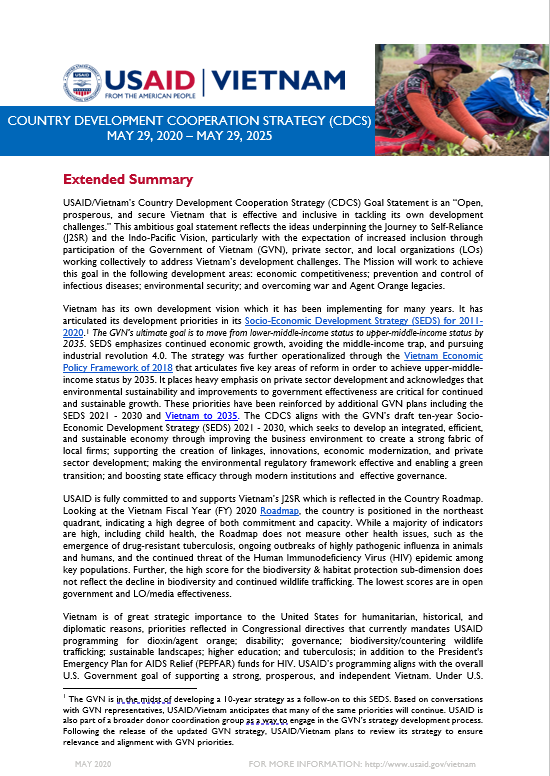Speeches Shim
USAID/Vietnam’s Country Development Cooperation Strategy (CDCS) Goal Statement is an “Open, prosperous, and secure Vietnam that is effective and inclusive in tackling its own development challenges.” This ambitious goal statement reflects the ideas underpinning the Journey to Self-Reliance (J2SR) and the Indo-Pacific Vision, particularly with the expectation of increased inclusion through participation of the Government of Vietnam (GVN), private sector, and local organizations (LOs) working collectively to address Vietnam’s development challenges. The Mission will work to achieve this goal in the following development areas: economic competitiveness; prevention and control of infectious diseases; environmental security; and overcoming war and Agent Orange legacies.
Vietnam has its own development vision which it has been implementing for many years. It has articulated its development priorities in its Socio-Economic Development Strategy (SEDS) for 2011-2020. The GVN’s ultimate goal is to move from lower-middle-income status to upper-middle-income status by 2035. SEDS emphasizes continued economic growth, avoiding the middle-income trap, and pursuing industrial revolution 4.0. The strategy was further operationalized through the Vietnam Economic Policy Framework of 2018 that articulates the key areas of reform in order to achieve upper-middle-income status by 2035. It places heavy emphasis on private sector development and acknowledges that environmental sustainability and improvements to government effectiveness are critical for continued and sustainable growth. These priorities have been reinforced by additional GVN plans including the SEDS 2021 - 2030 and Vietnam to 2035. The CDCS aligns with the GVN’s draft ten-year Socio-Economic Development Strategy (SEDS) 2021 - 2030, which seeks to develop an integrated, efficient, and sustainable economy through improving the business environment to create a strong fabric of local firms; supporting the creation of linkages, innovations, economic modernization, and private sector development; making the environmental regulatory framework effective and enabling a green transition; and boosting state efficacy through modern institutions and effective governance.
USAID is fully committed to and supports Vietnam’s J2SR which is reflected in the Country Roadmap. Looking at the Vietnam Fiscal Year (FY) 2020 Roadmap, the country is positioned in the northeast quadrant, indicating a high degree of both commitment and capacity. While a majority of indicators are high, including child health, the Roadmap does not measure other health issues, such as the emergence of drug-resistant tuberculosis, ongoing outbreaks of highly pathogenic influenza in animals and humans, and the continued threat of the Human Immunodeficiency Virus (HIV) epidemic among key populations. Further, the high score for the biodiversity & habitat protection sub-dimension does not reflect the decline in biodiversity and continued wildlife trafficking. The lowest scores are in open government and LO/media effectiveness.
Vietnam is of great strategic importance to the United States for humanitarian, historical, and diplomatic reasons, priorities reflected in Congressional directives that currently mandates USAID programming for dioxin/agent orange; disability; governance; biodiversity/countering wildlife trafficking; sustainable landscapes; higher education; and tuberculosis; in addition to the President's Emergency Plan for AIDS Relief (PEPFAR) funds for HIV. USAID’s programming aligns with the overall U.S. Government goal of supporting a strong, prosperous, and independent Vietnam. Under U.S. Foreign Assistance objectives, USAID programming builds our bilateral relationship with Vietnam and is in alignment with the Indo-Pacific Vision.
An Actor-aware Approach: The Mission’s focus in the goal statement on supporting Vietnam to tackle its own development challenges reflects the most important lesson from the previous CDCS: in order to further self-reliance, USAID must ensure that local champions own the results. Therefore, at the heart of this CDCS are three pillars of influence who are responsible for furthering Vietnam’s journey to self-reliance: the GVN, the private sector, and LOs. And beyond that, inclusivity has a deeper meaning of citizen engagement, including men, women, boys, girls, youth, elderly, persons with disabilities, and other marginalized populations. USAID/Vietnam will reinvigorate efforts to include those most vulnerable through program and activity design.
Turn to the private sector to identify business opportunities within development challenges: The private sector is a smaller, but rapidly growing pillar of influence, especially as a driver of the anti-corruption agenda, and in seeking and setting social and environmental standards. The Mission’s Private Sector Engagement (PSE) Strategy focuses specifically on creating shared value partnerships; the Mission works with its implementing partners and the private sector to identify where development challenges present business opportunities, leading to market-driven (as opposed to donor-driven) solutions. USAID/Vietnam will continue to invest in PSE and explore potential partnerships in new areas.
Expand the role of LOs and leverage the collective action model: The Mission will continue working with LOs where it has GVN’s concurrence and be opportunistic in expanding engagement where it sees openings. Based on stakeholder consultations and the Mission’s experience implementing Local Works programming, the Mission will explore and expand the collective action model for other areas of work, such as biodiversity, HIV prevention, and disabilities. Collective action, also known as collective impact, is a coordinated effort among a group of key actors representing various sectors (government, private sector, and LOs) that addresses a common agenda or specific social problem.




Comment
Make a general inquiry or suggest an improvement.